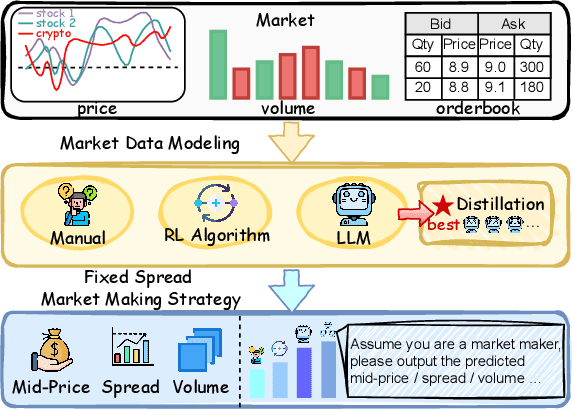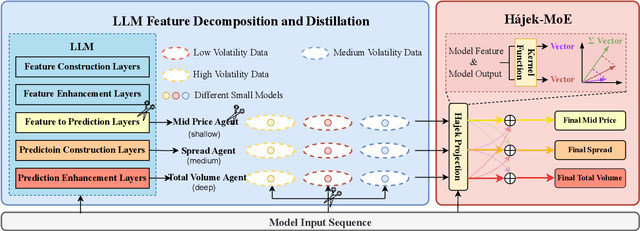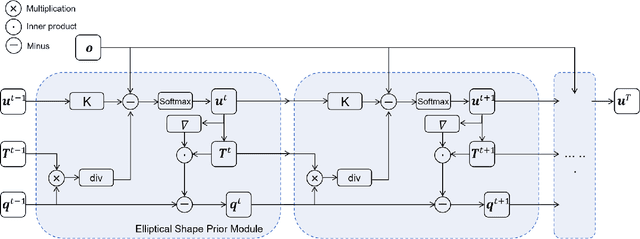Xinyu Zhao
Two Heads are Better than One: Distilling Large Language Model Features Into Small Models with Feature Decomposition and Mixture
Nov 11, 2025



Abstract:Market making (MM) through Reinforcement Learning (RL) has attracted significant attention in financial trading. With the development of Large Language Models (LLMs), more and more attempts are being made to apply LLMs to financial areas. A simple, direct application of LLM as an agent shows significant performance. Such methods are hindered by their slow inference speed, while most of the current research has not studied LLM distillation for this specific task. To address this, we first propose the normalized fluorescent probe to study the mechanism of the LLM's feature. Based on the observation found by our investigation, we propose Cooperative Market Making (CMM), a novel framework that decouples LLM features across three orthogonal dimensions: layer, task, and data. Various student models collaboratively learn simple LLM features along with different dimensions, with each model responsible for a distinct feature to achieve knowledge distillation. Furthermore, CMM introduces an Hájek-MoE to integrate the output of the student models by investigating the contribution of different models in a kernel function-generated common feature space. Extensive experimental results on four real-world market datasets demonstrate the superiority of CMM over the current distillation method and RL-based market-making strategies.
Metacognitive Self-Correction for Multi-Agent System via Prototype-Guided Next-Execution Reconstruction
Oct 16, 2025Abstract:Large Language Model based multi-agent systems (MAS) excel at collaborative problem solving but remain brittle to cascading errors: a single faulty step can propagate across agents and disrupt the trajectory. In this paper, we present MASC, a metacognitive framework that endows MAS with real-time, unsupervised, step-level error detection and self-correction. MASC rethinks detection as history-conditioned anomaly scoring via two complementary designs: (1) Next-Execution Reconstruction, which predicts the embedding of the next step from the query and interaction history to capture causal consistency, and (2) Prototype-Guided Enhancement, which learns a prototype prior over normal-step embeddings and uses it to stabilize reconstruction and anomaly scoring under sparse context (e.g., early steps). When an anomaly step is flagged, MASC triggers a correction agent to revise the acting agent's output before information flows downstream. On the Who&When benchmark, MASC consistently outperforms all baselines, improving step-level error detection by up to 8.47% AUC-ROC ; When plugged into diverse MAS frameworks, it delivers consistent end-to-end gains across architectures, confirming that our metacognitive monitoring and targeted correction can mitigate error propagation with minimal overhead.
GTCN-G: A Residual Graph-Temporal Fusion Network for Imbalanced Intrusion Detection (Preprint)
Oct 08, 2025Abstract:The escalating complexity of network threats and the inherent class imbalance in traffic data present formidable challenges for modern Intrusion Detection Systems (IDS). While Graph Neural Networks (GNNs) excel in modeling topological structures and Temporal Convolutional Networks (TCNs) are proficient in capturing time-series dependencies, a framework that synergistically integrates both while explicitly addressing data imbalance remains an open challenge. This paper introduces a novel deep learning framework, named Gated Temporal Convolutional Network and Graph (GTCN-G), engineered to overcome these limitations. Our model uniquely fuses a Gated TCN (G-TCN) for extracting hierarchical temporal features from network flows with a Graph Convolutional Network (GCN) designed to learn from the underlying graph structure. The core innovation lies in the integration of a residual learning mechanism, implemented via a Graph Attention Network (GAT). This mechanism preserves original feature information through residual connections, which is critical for mitigating the class imbalance problem and enhancing detection sensitivity for rare malicious activities (minority classes). We conducted extensive experiments on two public benchmark datasets, UNSW-NB15 and ToN-IoT, to validate our approach. The empirical results demonstrate that the proposed GTCN-G model achieves state-of-the-art performance, significantly outperforming existing baseline models in both binary and multi-class classification tasks.
Transferring Expert Cognitive Models to Social Robots via Agentic Concept Bottleneck Models
Aug 06, 2025Abstract:Successful group meetings, such as those implemented in group behavioral-change programs, work meetings, and other social contexts, must promote individual goal setting and execution while strengthening the social relationships within the group. Consequently, an ideal facilitator must be sensitive to the subtle dynamics of disengagement, difficulties with individual goal setting and execution, and interpersonal difficulties that signal a need for intervention. The challenges and cognitive load experienced by facilitators create a critical gap for an embodied technology that can interpret social exchanges while remaining aware of the needs of the individuals in the group and providing transparent recommendations that go beyond powerful but "black box" foundation models (FMs) that identify social cues. We address this important demand with a social robot co-facilitator that analyzes multimodal meeting data and provides discreet cues to the facilitator. The robot's reasoning is powered by an agentic concept bottleneck model (CBM), which makes decisions based on human-interpretable concepts like participant engagement and sentiments, ensuring transparency and trustworthiness. Our core contribution is a transfer learning framework that distills the broad social understanding of an FM into our specialized and transparent CBM. This concept-driven system significantly outperforms direct zero-shot FMs in predicting the need for intervention and enables real-time human correction of its reasoning. Critically, we demonstrate robust knowledge transfer: the model generalizes across different groups and successfully transfers the expertise of senior human facilitators to improve the performance of novices. By transferring an expert's cognitive model into an interpretable robotic partner, our work provides a powerful blueprint for augmenting human capabilities in complex social domains.
ChartMuseum: Testing Visual Reasoning Capabilities of Large Vision-Language Models
May 19, 2025Abstract:Chart understanding presents a unique challenge for large vision-language models (LVLMs), as it requires the integration of sophisticated textual and visual reasoning capabilities. However, current LVLMs exhibit a notable imbalance between these skills, falling short on visual reasoning that is difficult to perform in text. We conduct a case study using a synthetic dataset solvable only through visual reasoning and show that model performance degrades significantly with increasing visual complexity, while human performance remains robust. We then introduce ChartMuseum, a new Chart Question Answering (QA) benchmark containing 1,162 expert-annotated questions spanning multiple reasoning types, curated from real-world charts across 184 sources, specifically built to evaluate complex visual and textual reasoning. Unlike prior chart understanding benchmarks -- where frontier models perform similarly and near saturation -- our benchmark exposes a substantial gap between model and human performance, while effectively differentiating model capabilities: although humans achieve 93% accuracy, the best-performing model Gemini-2.5-Pro attains only 63.0%, and the leading open-source LVLM Qwen2.5-VL-72B-Instruct achieves only 38.5%. Moreover, on questions requiring primarily visual reasoning, all models experience a 35%-55% performance drop from text-reasoning-heavy question performance. Lastly, our qualitative error analysis reveals specific categories of visual reasoning that are challenging for current LVLMs.
Contour Field based Elliptical Shape Prior for the Segment Anything Model
Apr 17, 2025



Abstract:The elliptical shape prior information plays a vital role in improving the accuracy of image segmentation for specific tasks in medical and natural images. Existing deep learning-based segmentation methods, including the Segment Anything Model (SAM), often struggle to produce segmentation results with elliptical shapes efficiently. This paper proposes a new approach to integrate the prior of elliptical shapes into the deep learning-based SAM image segmentation techniques using variational methods. The proposed method establishes a parameterized elliptical contour field, which constrains the segmentation results to align with predefined elliptical contours. Utilizing the dual algorithm, the model seamlessly integrates image features with elliptical priors and spatial regularization priors, thereby greatly enhancing segmentation accuracy. By decomposing SAM into four mathematical sub-problems, we integrate the variational ellipse prior to design a new SAM network structure, ensuring that the segmentation output of SAM consists of elliptical regions. Experimental results on some specific image datasets demonstrate an improvement over the original SAM.
GuideLLM: Exploring LLM-Guided Conversation with Applications in Autobiography Interviewing
Feb 10, 2025



Abstract:Although Large Language Models (LLMs) succeed in human-guided conversations such as instruction following and question answering, the potential of LLM-guided conversations-where LLMs direct the discourse and steer the conversation's objectives-remains under-explored. In this study, we first characterize LLM-guided conversation into three fundamental components: (i) Goal Navigation; (ii) Context Management; (iii) Empathetic Engagement, and propose GuideLLM as an installation. We then implement an interviewing environment for the evaluation of LLM-guided conversation. Specifically, various topics are involved in this environment for comprehensive interviewing evaluation, resulting in around 1.4k turns of utterances, 184k tokens, and over 200 events mentioned during the interviewing for each chatbot evaluation. We compare GuideLLM with 6 state-of-the-art LLMs such as GPT-4o and Llama-3-70b-Instruct, from the perspective of interviewing quality, and autobiography generation quality. For automatic evaluation, we derive user proxies from multiple autobiographies and employ LLM-as-a-judge to score LLM behaviors. We further conduct a human-involved experiment by employing 45 human participants to chat with GuideLLM and baselines. We then collect human feedback, preferences, and ratings regarding the qualities of conversation and autobiography. Experimental results indicate that GuideLLM significantly outperforms baseline LLMs in automatic evaluation and achieves consistent leading performances in human ratings.
Dialogue is Better Than Monologue: Instructing Medical LLMs via Strategical Conversations
Jan 29, 2025Abstract:Current medical AI systems often fail to replicate real-world clinical reasoning, as they are predominantly trained and evaluated on static text and question-answer tasks. These tuning methods and benchmarks overlook critical aspects like evidence-based reasoning and handling distracting information. To bridge this gap, we introduce a novel benchmark that simulates real-world diagnostic scenarios, integrating noise and difficulty levels aligned with USMLE standards. Moreover, we explore dialogue-based fine-tuning, which transforms static datasets into conversational formats to better capture iterative reasoning processes. Experiments show that dialogue-tuned models outperform traditional methods, with improvements of $9.64\%$ in multi-round reasoning scenarios and $6.18\%$ in accuracy in a noisy environment. Our findings highlight dialogue tuning as a promising approach for advancing clinically aligned and robust medical AI systems.
BrainMAP: Learning Multiple Activation Pathways in Brain Networks
Dec 23, 2024Abstract:Functional Magnetic Resonance Image (fMRI) is commonly employed to study human brain activity, since it offers insight into the relationship between functional fluctuations and human behavior. To enhance analysis and comprehension of brain activity, Graph Neural Networks (GNNs) have been widely applied to the analysis of functional connectivities (FC) derived from fMRI data, due to their ability to capture the synergistic interactions among brain regions. However, in the human brain, performing complex tasks typically involves the activation of certain pathways, which could be represented as paths across graphs. As such, conventional GNNs struggle to learn from these pathways due to the long-range dependencies of multiple pathways. To address these challenges, we introduce a novel framework BrainMAP to learn Multiple Activation Pathways in Brain networks. BrainMAP leverages sequential models to identify long-range correlations among sequentialized brain regions and incorporates an aggregation module based on Mixture of Experts (MoE) to learn from multiple pathways. Our comprehensive experiments highlight BrainMAP's superior performance. Furthermore, our framework enables explanatory analyses of crucial brain regions involved in tasks. Our code is provided at https://github.com/LzyFischer/Graph-Mamba.
Accelerating Vision Diffusion Transformers with Skip Branches
Nov 26, 2024



Abstract:Diffusion Transformers (DiT), an emerging image and video generation model architecture, has demonstrated great potential because of its high generation quality and scalability properties. Despite the impressive performance, its practical deployment is constrained by computational complexity and redundancy in the sequential denoising process. While feature caching across timesteps has proven effective in accelerating diffusion models, its application to DiT is limited by fundamental architectural differences from U-Net-based approaches. Through empirical analysis of DiT feature dynamics, we identify that significant feature variation between DiT blocks presents a key challenge for feature reusability. To address this, we convert standard DiT into Skip-DiT with skip branches to enhance feature smoothness. Further, we introduce Skip-Cache which utilizes the skip branches to cache DiT features across timesteps at the inference time. We validated effectiveness of our proposal on different DiT backbones for video and image generation, showcasing skip branches to help preserve generation quality and achieve higher speedup. Experimental results indicate that Skip-DiT achieves a 1.5x speedup almost for free and a 2.2x speedup with only a minor reduction in quantitative metrics. Code is available at https://github.com/OpenSparseLLMs/Skip-DiT.git.
 Add to Chrome
Add to Chrome Add to Firefox
Add to Firefox Add to Edge
Add to Edge